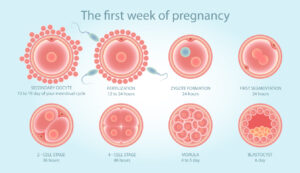About Fertility
How Do You Choose the Best Blastocyst for Transfer?

Many patients ask how you choose the best blastocyst for transfer during an IVF cycle. A Day 5 transfer allows us to choose the best embryos for transfer more accurately. Embryos on Day 5 have reached what is called the blastocyst stage and have already started to differentiate into future placental tissue and fetal tissue. Our lab’s ability to limit the time the embryos are out of the incubator has increased our ability to grow more blastocysts and further choose the best 1 or 2 embryos. This has led to much higher pregnancy rates.
Can You Tell If a Blastocyst Is Chromosomally Normal?
Other than performing preimplantation genetic testing, the embryologist cannot assess with the naked eye which embryos are chromosomally normal. What we do have is years of research in morphometrics which outlines which embryonic markers are more likely to result in a live birth. Embryos are grown in culture media under controlled conditions to mimic the human body (temperature and pH). The longer the embryos stay in culture, the more information we have to differentiate each embryo. Embryos are evaluated on Day 1,2, 3, and 5, and every score is taken into consideration when choosing embryo(s) for transfer. 1 embryo = 1 baby is the ultimate goal. One paramount expanded blastocyst to transfer on Day 5 that results in a healthy baby with a small cohort to cryopreserve for subsequent frozen embryo transfers indicates a successful IVF cycle.
What Are the Chances of a Day 5 Blastocyst Implantation?
Data shows that the trophectoderm (the outer cells of the blastocyst, which make the placenta) is the most important embryonic marker for implantation success. The cells should appear scalloped and cohesive. The inner cell mass (ICM, which will form the fetus) is also very important to score and contributes to the overall grade of the embryo. This group of cells should be prominent in the cavity. The blastocele (fluid-filled center) should be expanded, and the zona should be thin. Thinning of the zona is extremely important for the hatching of the blastocyst; as the blastocyst expands, the zona thins, allowing hatching out, which must occur for implantation into the endometrium.

Blastocyst and Embryo Freezing In IVF
Our ability to freeze embryos at the blastocyst stage via vitrification has led to 90% survival of the embryos after warming them. This has also led to a much higher pregnancy rate during a frozen embryo transfer cycle.
Contact Us
At Fertility Centers of New England, our team keeps on top of the latest advances in assisted reproductive technology and tailors treatment for each person.
If you have more questions on how to choose the best blastocyst for transfer, please contact us to schedule your initial consultation.


